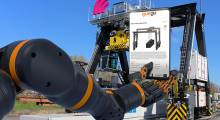Editor’s note: The following column by Jake Rheude, vice president of marketing for Red Stag Fulfillment, an order fulfillment company for online retailers and ecommerce businesses, is part of Modern’s Other Voices column, a series featuring ideas, opinions and insights from end-users, analysts, systems integrators and OEMs. Click here to learn about submitting a column for consideration.
————-
The world of sales is moving ahead at breakneck speed, and the supply chain is doing its best to keep up with growing demands. E-commerce sales are the biggest driver of the ongoing evolution of the supply chain, and it’s worth taking a step back to look at what’s new and next from 50,000 feet.
Today’s digital retailers are faced with increased customer demands and competition, creating a need to innovate and differentiate via the supply chain, all while controlling costs. Consumers are price- and time-sensitive, which places significant pressure on every warehouse.
Cutting-edge technologies are stepping up to meet these demands, even as the mantra of always being lean is repeated. Here are five areas of innovation and potential we see for the evolved supply chain playing a decisive role in the future of e-commerce.
Addressing same-day demands
Depending on which professional or researcher you ask, customers care most about product cost or delivery time. The dominance of companies like Amazon has pushed two-day shipping options to become standard in many cases. What the space faces next is a preference and competitive advantage of one-day or same-day shipping demands.
And customers are willing to pay for it. Same-day shipping is a multi-billion-dollar opportunity that is expected to grow continuously through 2025 thanks to e-commerce offers and consumers being always connected to the Internet.
Meeting this demand requires real-time inventory understanding throughout a supply chain, including options to turn almost any point in a supply chain to a distribution node. If an e-commerce retailer could work with 3PLs that guarantee this reach or make arrangements with manufacturers and suppliers to ship both individual items as well as in bulk, they’re able to flex the supply chain and make same-day options possible in a broader set of customer locations.
Adapting to quick customer-demand changes
The evolved supply chain is one that prioritizes flexibility alongside the customer experience. E-commerce tools already prioritize making the purchase and delivery as seamless as possible for the customer, regardless of how many companies are involved in the process.
You might not even realize you were ordering from a drop-shipper when things go right. Part of the reason for this is that having only a single point of interaction for your entire order — as the customer — makes it easier to ask questions, get responses, track packages, and do anything else you need related to that order.
Supply chains can support this customer experience by making it easy to send data up and down the chain, with real-time information delivered via APIs and automated updates. Websites can pull this information together in an instant, so the customer never has to leave your e-commerce store or helpdesk to find what they need.
For the e-commerce brand, this builds reliability and trust. Handling questions directly can help customers like you more and keep them on your site, which can impact your ability to land another sale if they’re satisfied. The evolved supply chain will play a direct role in your ROI and customer lifetime value.
Automation can ease team stress
Cloud solutions have become the standard model of deployment for supply chain tech, thanks mainly to availability and reduced infrastructure demands. Cloud services also give companies a lot of processing power on-the-go.
The next step in this evolution is likely to be the adoption of robotics and automation tools, as well as predictive analytics. Robotic process automation (RPA) is a prime target for an initial investment. This is where you show a bot how to complete a task, and then it follows the exact same steps each subsequent time it is needed. You can turn a manual, intense, time-consuming task into something that happens at lightning speed. Plus, there is no risk of human error for tedious or repetitive tasks.
It’s especially useful when you need to perform tasks that can’t be automated in other ways or through partner software. Automation can help with tracking inventory levels, sending purchase orders up the supply chain as needed without any human involvement, and even managing contract data for supplier management.
When a task has a pre-defined level or actionable need, you can turn it over to a machine to continuously monitor things and take that action. This pulls your team away from low-value tasks and allows them to focus on high-value operations, managing your human capital needs as well as providing greater efficiencies and job satisfaction.
E-commerce impacts more channels
E-commerce companies should look through their supply chain to see how it affects other industries and operations. This can provide some insight as to where they can look for innovation or support. Many small companies will think mostly of their nearest supplier or mode of transit, but there’s a lot more under the surface.
For instance, e-commerce supply chains are playing a significant role in the growth of U.S. ports, protecting some against declines related to tariffs on Chinese goods.
As an e-commerce company grows, it should look at how far its supply chain reaches and see what advantages might be available at each point. It might be more economical to acquire industrial space near a port for local distribution. Or, as tariffs and availability change, companies may need to bulk order goods ahead of price increases.
The more evolved and forward-looking a supply chain, the easier it is for a company to adapt to global pressure and find ways to innovate or save.
Supporting what’s next
Supply chains stay lean and keep operational costs low by prioritizing what works now and being open to what will work next. This is going to become even more critical if e-commerce trends continue, as demand for carriers and trucks could outstrip supply.
Delivery is going to be a significant issue for all of us — retailers, e-commerce stores, 3PLs, and carriers — to tackle in 2020. A smarter, more evolved supply chain could be your best bet to addressing the challenge and thriving.
We’re not sure if a rise of autonomous vehicles and drones dropping off packages from unified last-mile facilities is soon to be a new reality or has a few years before it’s more than just PR efforts. No one is sure if AI and neural networks will allow some distribution centers to find brand-new ways of pre-staging goods to meet demands or if customers will adopt local lockers and pick-up locations en masse.
The future is uncertain and exciting. What we do see as necessary for growing in that future is the ability for the supply chain, and every company in it, to adapt and flex to meet changes in customer and client demands.
Article topics
Email Sign Up















